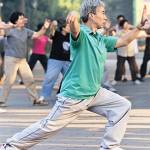A traditionally strong factor to consider in CVD risk is physical activity. Adults with RA accumulate less time spent engaged in physical activity than healthy peers (1,836 vs. 2,199 minutes per week, P=0.001).25 Physically inactive patients with RA have a higher probability of a 10-year CVD event (higher systolic blood pressure, P=0.006, cholesterol, P<0.001, low-density lipoprotein, P=0.01) when compared with physically active RA subjects, suggesting that low physical activity levels may serve as an independent risk factor for CVD events in adults with RA.6,26
Improving the lipid profile of RA patients is important to lower the risk of CVD events, and exercise training can offer this effect.27,28 Although total time spent engaging in physical activity is of great importance, the literature on how exercise improves habitual physical activity is scarce.
Instead, exercise interventions have looked to improve the CRF profile (commonly defined as VO2 max in mL/kg/min) of RA patients, a profile historically 20–30% lower than that of healthy controls.11 Not specific to RA patients, links between CRF and dyslipidemia have been noted, making interventions aimed at improving CRF interesting for attenuating the CVD risk in RA.29
Results from a Cochrane review revealed that land-based aerobic exercise interventions significantly improved aerobic capacity (VO2 max in mL/kg/min) with an effect size of 0.99 (0.29, 1.68).5 Although water-based aerobic exercise had an overall effect size of 0.47, the effect was not significant (-0.04, 0,98), making it hard to deduce its potency.5 Presently, it is difficult to determine the most suitable intensity, frequency or duration for optimal CR improvements in RA, because the number of studies is low.
Disease Activity—Exercise
Disease activity in RA has clinical meaning, because patients with higher disease activity report lower quality of life and spend less time being physically active.30,31 There are many ways of measuring disease activity in RA.32 In exercise interventions, the Disease Activity Scale (DAS-28) is commonly used. Despite its shortcomings in differentiating disease activity, studies tend to define a DAS greater than 5.1 as active disease, less than 3.2 as low disease activity and less than 2.6 as remission.33,34 Today, it is widely considered safe to indulge in physical activity and exercise no matter the level of disease activity.35
In an exercise study conducted for patients with highly active RA (7.0), the exercise group demonstrated a greater decrease in disease activity compared with the control group (effect size of 0.49 and 0.29 respectively), paving the way for more studies on physical activity and disease activity, although not all studies reveal significant positive effects.36,37


